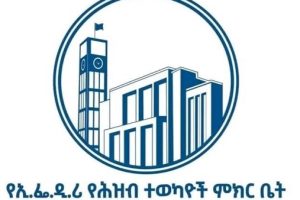The objective of the manufacturing sub-sector in the Second Growth and Transformation Plan (GTP II), which encompasses 2015/16 -2019/2020 fiscal years, is centered to make Ethiopia a leading light industries manufacturing hub in Africa and among the leading countries in the globe, thereby transforming the country into a lower middle –income economy by 2025.
Recently, National Planning Commission issued the GTP II Midterm Review Report which has been given a detailed evaluation and analysis in Ethiopia’s performance in attaining major economic targets whilst attached utmost priority for the performance in 2016/17 fiscal year. The Ethiopian Herald has made attempt to present highlights of the manufacturing sector’s performance in the aforementioned year.
Planning and Development Commissioner Dr. Fistum Assefa said that the strategic directions of the manufacturing sub-sector in GTP II consist of improving the productivity, quality and competitiveness of both existing and new industrial products and laying the basis for structural change; building labor-intensive light manufacturing industries that are globally competitive in terms of productivity, quality and price.
Transforming the medium and large manufacturing industries so that they become a reliable source of foreign exchange and building industrial engineering and technological capacity of the country are also among the priorities of the plan. Apart from improving the production and capacity of existing industries, the government has also made efforts to attract new and high quality local and foreign direct investment (FDI) into the manufacturing industry.
The commissioner stated that the development of high tech and light manufacturing industries is linked; metal and engineering as well as chemical and pharmaceuticals industries are expanded to substitute strategically imported items by locally produced goods and reduce the pressure on foreign exchange demand for imports.
Ethiopia has exerted enormous efforts in expanding industrial parks and establishing clusters, as well as creating linkage between domestic and foreign firms to facilitate the transfer of technology, skill in order to bring about structural transformation. In addition, strategic areas that fail to attract the private sector but have far-reaching positive externalities in the wider economy are selectively identified for development by the government alone or in partnership with the private sector.
According to Dr. Fistum, the manufacturing subsector grew by 17.4 percent during the 2016/17 fiscal year as a result of new investments in the subsector and improved production capacity utilization of the existing factories.
The performance of some branches of the manufacturing sub-sector in 2016/17 fiscal year presents as follows:
A. Medium and large-scale manufacturing industries
Textile and garment industry- During 2016/17, production capacity utilization of the existing manufacturing plants reached 57 percent, while, in the same period, 19 out of the expected 23 new projects started production.
Export earnings of this branch of the manufacturing industry reached 89.3 million USD in contrast to the planned target of 270.5 million USD. The textile and garment industries created about 17,447 new workers (of whom 1,319 male and 16, 128 female). Raw material supply is largely impacted on the performance of the branch.
Leather and leather products industry- The gross value of production of this branch of the manufacturing industry during the stated period amounted to 230 million USD and export earnings from the branch stood at 114 million USD. Leather shoes, finished leather and other leather products contributed the majority of the branch’s total export earnings respectively.With respect to job creation, the branch was created 9,157 new employments.
Metals, engineering and electronics industry- During same period, this branch of manufacturing industry supplied 985,293 tons of iron and steel products out of the country’s total consumption of 2,238,753 tons, as well as generated 800 million USD from export. Earnings of from electric and electronic products export reached 44.1 million USD and the main export products were electric cables and mobile cellphones. In terms of new job creation, 518 permanent and 629 temporary job opportunities were created in the sub-sector.
Meat, milk, fish, and honey and wax industry- 103.5 million USD was obtained from the export of meat, milk, fish, honey and wax in the 2016/17 and this industry attained 71 percent of the plan. The export performance of the fiscal year has shown an improvement compared to the preceding two fiscal years.
Food and beverage (agro-processing) industry- The branch generated 35.5 million USD in the 2016/17 fiscal year and the number surpassed the preceding fiscal year’s earnings by 8.6 percent due to the increase in the capacity utilization of the existing factories in the food industry.
Pharmaceutical industry- The objective of the pharmaceutical industry during the 2016/17 fiscal year was to increase the capacity utilization of the existing pharmaceutical plants, enhance import substitution and increase pharmaceutical exports to generate foreign exchange earnings.
The export revenue earnings remained very low and stood at 3.1 million USD against the target of 54.8 million USD for the fiscal year. On the other hand, the plan to increase the domestic market share of the products of the pharmaceutical industry to 20 percent has been fully achieved. With respect to employment, the industry created 2,400 new job opportunities during the fiscal year under review.
Chemical and construction inputs industry- Efforts in this branch during the fiscal year 2016/17 focused on improving production capacity utilization of the existing plants and on increasing export earnings. Regarding export earnings, 14.1 million USD secured from the sector. The branch performed comparatively better in terms of employment creation and it employed 5,859 new workers of whom 45 percent were women.
Sugar manufacturing industry- The plan target for sugar production during the year under review was 564,205 tons excluding Tendaho I, while the actual production amounted to 351,504 tons, falling short of the target by 36.8 percent, tough it exceeded the preceding fiscal year’s production by 14.9 percent. In addition to sugar, the factories also produced over 12,370 cubic meters of ethanol as well as 150, 740 tons of molasses.
The government of Ethiopia has been investing heavily in sugar development and the status of the various sugar development projects was as follows: Beles I sugar project (77 percent completed), Beles II (25 percent), Omo Kuraz III (80 percent), Omo Kuraz V (24 percent) and Wolkayit (55 percent).
B. Small and medium scale manufacturing industries
During the fiscal year 2016/17, business plans of 1,023 small and medium scale manufacturing industries (with 1,642 male and 755 female members) were approved by the Capital Lease Finance Share Company. Similarly, in line with the Development Bank of Ethiopia’s Capital Lease Finance producers, requests worth 3.8 billon birr were approved.
C. Industrial parks and clusters development program
The commissioner pointed out that the development of industrial parks and clusters has a key role in boosting the manufacturing industry development, and the progress in this respect is very promising. Currently, a number of industrial parks are under construction including Addis Ababa Industry Village, Bole Lemi I and II, and Kilinto Industry Park in Addis Ababa; Hawassa Industry Park in SNNPS; Mekele Industry Park in Tigray; Bahir Dar and Kombolcha industrial parks in Amhara; Adama and Jimma industrial parks in Oromia; and Dire Dawa Industry Park.
During the fiscal year 2016/17, the construction of Addis Ababa Industry Village, Bole Lemi I Industry Park and Hawassa Industry Park have been completed. In addition, preparations are underway to launch construction of the Debereberhan, Arerti, and Aysha/ Dewele industry park projects.
Integrated agro-industry parks development
She further stated that the development of integrated agro-industry parks has been taken as a key strategy for transforming the economy by linking the agriculture sector with industry to enhance value addition through agro-processing. For this purpose, 17 development corridors have been identified. Feasibility studies (including detailed economic and environmental impact assessment) on four corridors: Humera in Tigray, Bure in Amhara, Bulbula area in Oromia and Yirgalem area in SNNPS have been undertaken with financial support from various development partners, and construction of the parks is underway. Various government organs come to terms to work closely in a coordinated manner and a four-year strategic plan has been prepared to ensure the supply of raw material inputs for the agro-processing industry parks.
Information obtained from Industrial Parks Development Corporation indicated that an international consultant has been hired and activities have been commenced to develop standard industrial clusters that can accommodate small and medium scale industries that can produce commodities destined for the export market. The industrial clusters, which are going to be developed under the ownership of state governments, would have the capacity to accommodate manufacturing processes at one center at specified locations and the construction of the industry clusters is expected to play a significant role in the development of small and medium scale manufacturing.
Investment expansion program
According to the report, technical support was given to domestic businesses in the preparation of business plans to encourage domestic investors to engage in small and medium scale manufacturing industries. In addition, domestic investors were encouraged to organize themselves to facilitate machinery lease financing from the Development Bank of Ethiopia.
Sharing best practices of model manufacturing enterprises with other enterprises has also been undertaken to improve productivity, quality and competitiveness. In connection with attracting FDI, promotional documents were prepared and promoted in collaboration with the Ministry of Foreign Affairs and the Ethiopian Investment Commission in selected countries. In particular, well known and capable global investors were selected and approached and were provided with comprehensive information on available investment opportunities in Ethiopia to encourage investment decisions.
Heavy investment development- Development of heavy industries is the foundation of industrialization. A prefeasibility study for establishing heavy metal and chemical industries is being conducted with the assistance of development partners and it is expected to be completed shortly.
Electronics and communication industries- Studies for the development of electronics and information communication technology (ICT) industry have been undertaken and six products namely Computer and Computer Equipment, Communication Equipment, Cable and Wiring Devices, Domestic Appliances Manufacturing, Electric Motor Manufacturing and out of resource application development were prioritized for initial startup of production.
In cooperation with UNIDO and the World Bank, preparations are underway to conduct detailed feasibility studies to lay the foundation for the development of these industries.
Bio-technology development- In order to make use of the country’s rich biodiversity resources, a roadmap for industrial scale production of bio-resource products has been completed. Preparations for an institutional arrangements and coordination among relevant institutions are also underway.
Wooden furniture industries development- One of the potentials in which Ethiopia has competitive advantage is the area of the development of wood-based product industries. With the support of the World Bank, a study combining forestry development and wood-based products industries is being undertaken by a foreign consultancy firm, while agreement has already been reached with the then Ministry of Environment, Forest and Climate Change to implement the findings of the study.
Climate change resilient green industry development- Investment and operational costs sharing proposals have been prepared by the government to facilitate the implementation of the revised regulations and guidelines on environmental protection. Accordingly, textile factories are required to recycle liquid waste and reuse it.
Discharge of any waste to the environment is forbidden. In particular, domestic factory owners were instructed to introduce zero discharge technology to their waste management operation based on the cost sharing principle. During the 2016/17 fiscal year, carbon emission has been reduced by five percent against the target 20 percent.
The government was also undertaking a study in liquid waste treatment and management system in the Hawassa Industry Park in collaboration with stakeholders to realize the green industries agenda, the report noted.
December 18/2018
BY BILAL DERSO




